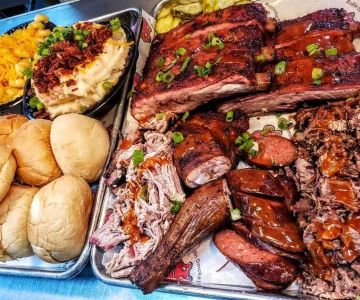- 1-Understanding-the-Rise-of-Dietary-Restrictions
- 2-Strategies-Restaurants-Use-to-Accommodate-Dietary-Needs
- 3-Real-Life-Examples-of-Restaurant-Adaptations
- 4-Challenges-and-Opportunities-in-Adapting-Menu-Options
- 5-How-Senix-Table-Supports-Restaurants-and-Diners
1. Understanding the Rise of Dietary Restrictions
In recent years, the growing awareness of dietary restrictions has significantly reshaped the restaurant industry. From food allergies and gluten intolerance to vegetarian, vegan, and keto lifestyles, more customers expect dining options that respect their health needs and personal choices.
Understanding how restaurants are adapting to dietary restrictions is essential for appreciating this cultural shift. The demand for safe, inclusive, and creative menu options reflects broader societal trends emphasizing wellness and personalization.
1.1 Factors Driving Change
Several factors contribute to this rise, including increased diagnoses of food allergies, greater visibility of dietary lifestyles on social media, and evolving consumer expectations for transparency and health-conscious offerings.
2. Strategies Restaurants Use to Accommodate Dietary Needs
Restaurants are employing diverse strategies to meet the needs of customers with dietary restrictions while maintaining quality and flavor.
2.1 Menu Diversification and Labeling
Many establishments now feature clearly labeled menus identifying gluten-free, dairy-free, nut-free, vegan, and other special diet options. This transparency helps customers make informed choices confidently.
2.2 Staff Training and Kitchen Protocols
Proper staff education on cross-contamination risks and ingredient awareness is crucial. Restaurants implement rigorous kitchen practices to prevent allergen exposure and ensure safe food preparation.
2.3 Customizable Dishes
Offering customizable meals enables customers to adjust dishes to their dietary needs, such as substituting ingredients or removing certain components, enhancing inclusivity and satisfaction.
3. Real-Life Examples of Restaurant Adaptations
One inspiring example is a well-known chain that launched a dedicated gluten-free menu after recognizing a surge in customer demand. Their transparent ingredient sourcing and separate prep areas won praise from the celiac community and increased their loyal customer base.
Another story comes from a local vegan bistro that innovatively uses plant-based proteins to recreate traditional dishes, appealing to both vegans and curious omnivores. Their success underscores how dietary restrictions can spark culinary creativity.
4. Challenges and Opportunities in Adapting Menu Options
While adapting to dietary restrictions offers opportunities to expand clientele and improve reputation, restaurants face challenges including increased food costs, staff training needs, and maintaining flavor consistency.
Balancing these challenges requires thoughtful planning and a commitment to continuous improvement. However, the payoff is significant—both in customer loyalty and positive brand image.
5. How Senix Table Supports Restaurants and Diners
For restaurants aiming to excel in accommodating dietary restrictions, Senix Table provides tailored solutions including menu consulting, staff training programs, and ingredient sourcing guidance.
By partnering with Senix Table, businesses gain expert support to innovate their menus and ensure safe dining experiences for all customers. Diners can also discover trusted restaurants that prioritize dietary needs, making informed choices easier and more enjoyable.
Embracing how restaurants are adapting to dietary restrictions is more than a trend—it’s a vital evolution toward inclusivity and health-focused dining, and Senix Table stands ready to guide this journey.







 Mi Luna Tapas Restaurant & Bar4.0 (490 reviews)
Mi Luna Tapas Restaurant & Bar4.0 (490 reviews) Medellin3.0 (183 reviews)
Medellin3.0 (183 reviews) Katz's4.0 (7417 reviews)
Katz's4.0 (7417 reviews) Frisky Whisky4.0 (108 reviews)
Frisky Whisky4.0 (108 reviews) Farmer's Fridge0.0 (0 reviews)
Farmer's Fridge0.0 (0 reviews) Slammin' Salmon (Food Truck)5.0 (49 reviews)
Slammin' Salmon (Food Truck)5.0 (49 reviews) Best Places for Seafood Boils and Clambakes Across the U.S.
Best Places for Seafood Boils and Clambakes Across the U.S. Discover Delicious Vegan Desserts at Local Bakeries Near You
Discover Delicious Vegan Desserts at Local Bakeries Near You Best Late-Night Eats in Major U.S. Cities: Where to Satisfy Your Midnight Cravings
Best Late-Night Eats in Major U.S. Cities: Where to Satisfy Your Midnight Cravings The Ultimate Guide to New Year’s Eve Dining in Major Cities
The Ultimate Guide to New Year’s Eve Dining in Major Cities The Future of Sustainable Restaurants in America: Trends and Innovations
The Future of Sustainable Restaurants in America: Trends and Innovations Best Smoothie and Juice Bars for a Quick Healthy Bite
Best Smoothie and Juice Bars for a Quick Healthy Bite